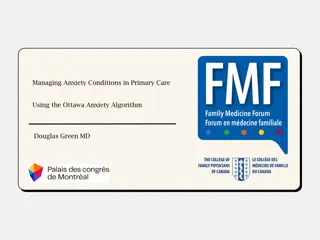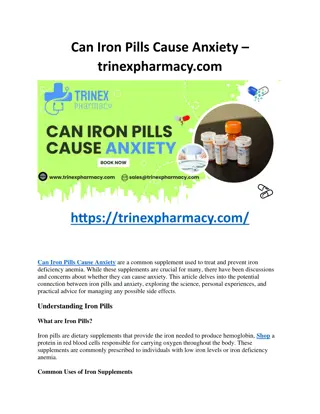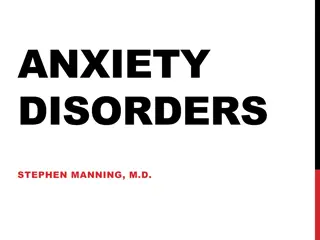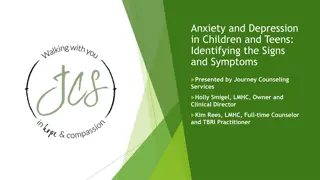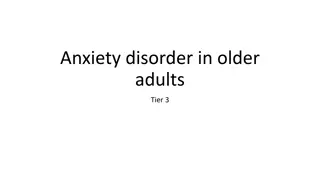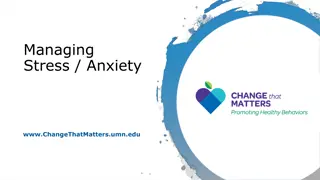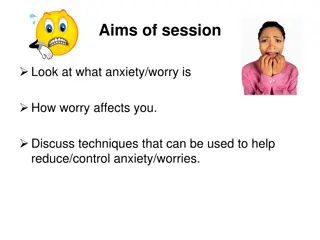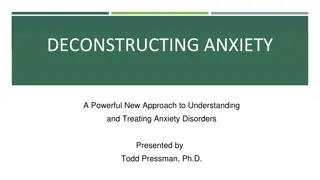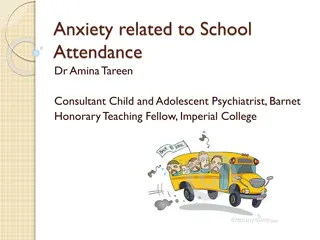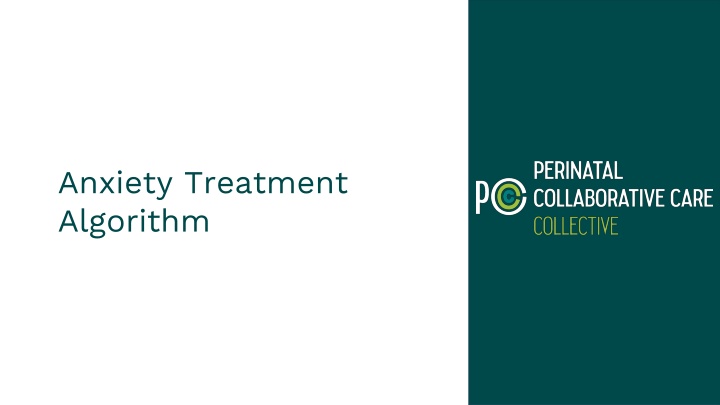
Effective Anxiety Treatment Guidelines and SSRI Use During Pregnancy
This detailed content provides an anxiety treatment algorithm, focusing on SSRI and SNRI medication use, dose adjustments, and considerations during pregnancy. It includes SSRI treatment algorithms, discussion points about SSRIs during pregnancy, and emphasizes the importance of comprehensive care for perinatal anxiety.
Download Presentation

Please find below an Image/Link to download the presentation.
The content on the website is provided AS IS for your information and personal use only. It may not be sold, licensed, or shared on other websites without obtaining consent from the author. If you encounter any issues during the download, it is possible that the publisher has removed the file from their server.
You are allowed to download the files provided on this website for personal or commercial use, subject to the condition that they are used lawfully. All files are the property of their respective owners.
The content on the website is provided AS IS for your information and personal use only. It may not be sold, licensed, or shared on other websites without obtaining consent from the author.
E N D
Presentation Transcript
Anxiety Treatment Algorithm
Anxiety Treatment Algorithm Continued evidence of anxiety Currently taking an SSRI or SNRI medication? Yes No If SSRI or SNRI has helped, but the birthing person is still symptomatic, increase dose of current medication unless side effects are prohibitive (see table on next slide) Does the birthing person have a history of taking any SSRI or SNRI that has helped? Yes No If on maximum dose, But GAD7 remains 10, consider changing medication. Screen with MDQ, then prescribe the SSRI or SNRI that helped patient in the past (see table on next slide) Screen with MDQ, then use sertraline or escitalopram (see table on next slide) Contact Care Manager to facilitate Psychiatry Consultation
SSRI Treatment Algorithm+ Use half the lowest recommended dose for 4-10 days, then increase in specified increments every 2-4 weeks until birthing person achieves remission or has side effects* Escitalopram (Lexapro) 5-20 mg Sertraline (Zoloft) 50-250 mg Fluoxetine (Prozac) 20-80 mg Citalopram (Celexa) 10-40 mg Increase in 50 mg increments Increase in 10 mg increments Increase in 10 mg increments Increase in 5 mg increments o o o o Reevaluate anxiety treatment every 2 weeks via GAD7 and clinical assessment If GAD7 is < 5 and no/minimal side effects... If GAD7 remains 5 o If no minimal side effects, increase dose and/or add psychotherapy o If side effects*, consider switching to different medication o If on max dose, contact Care Manager to facilitate psychiatry consultation o Reevaluate monthly Educate: Within first few doses, if the patient experiences an increase in anxiety/agitation or feels energized, stop the medication and contact the Care Manager for an evaluation. +Remember to administer MDQ prior to any pharmacotherapy for suspected anxiety *Common side effects of SSRIs include: nausea, dry mouth, insomnia, diarrhea, headache, dizziness, agitation, sexual problems, and drowsiness
Discussion Points About SSRIs During Pregnancy General Overview: No decision during pregnancy is risk free SSRI (Selective Serotonin Reuptake Inhibitors) are among the best studied class of medications during pregnancy Both medication and non-medication options should be considered Encourage non-medication treatments (e.g., psychotherapy) in addition to medication treatment and/or as an alternative when clinically appropriate Risks of under-treatment or no treatment of anxiety during pregnancy... Antidepressant use during pregnancy may increase risk of... Transient neonatal signs Postpartum anxiety Persistent pulmonary hypoplasia of the newborn Preeclampsia Preterm birth Suicide Substance misuse Poor self-management Impaired attachment between birthing person and infant Risk of mental health conditions in child Un- or under- treated perinatal anxiety is associated with negative outcomes for the birthing person, baby, and family
Benzodiazepine Treatment Algorithm+ Currently Taking a Benzodiazepine? Yes No Start serotonergic treatment for long-term symptom management (see slides 2-3) Sporadic use (e.g., less than daily use for panic disorder) Daily use If the individual needs acute symptomatic relief: Does the individual have history of or current substance use? Are they currently using any opioid medication? Symptomatic: Recommend continuing benzodiazepine while maximizing serotonergic medication Reassess symptoms every 4 weeks Asymptomatic: Discuss option of tapering off benzodiazepine Inadequate symptom control Adequately symptom control Yes No Contact Care Manager to facilitate Psychiatry Consultation Avoid Benzodiazepines Hydroxyzine 25-50mg q8h prn anxiety/sleep Hydroxyzine 25-50mg q8h prn anxiety/sleep Decrease by 0.25-0.5mg every 3-14 days based on tolerability Continue intermittent use with close symptom monitoring by Care Manager If remains symptomatic with severe and debilitating sx, consider brief course (2-4 weeks) of benzodiazepine (see next slide) while up-titrating SSRI If remains symptomatic, contact Care Manager to facilitate Psychiatry Consultation Continued symptoms despite SSRI
Benzodiazepine Treatment Algorithm+ Consider Limiting Use To: 1. Short term use (1-2 weeks) for severe and disabling anxiety (while up-titrating SSRI) 2. Intermittent (prn) use for acute panic attacks Lorazepam (Ativan) Clonazepam (Klonopin) Alprazolam (Xanax) High potency Peak Onset: 1-4hrs T1/2 18-39hrs Dosing: 0.5-1mg daily prn Short acting, high potency Peak Onset: 0.7-1.6hrs T1/2 6-27hrs Dosing: 0.25-0.5mg tid prn Not preferred as there is a high risk of rebound Short acting, high potency Peak Onset: 1-1.5hrs T1/2 10-20hrs Dosing: 0.5-1mg bid prn Preferred benzodiazipine due to: A. Quick onset and length of action that both minimizes rebound anxiety and reinforcing phenomena seen w/ alprazolam B. Shorter length of action compared to clonazepam can minimize fetal exposure Educate Patient: o Benzodiazepines can cause sedation and should not be used with other sedating medication o Benzodiazepines should not be used in combination with opiates due to risk of sedation and respiratory depression o Benzodiazepines carry a risk of dependence with daily use for over 6 weeks Decreased efficacy over time and withdrawal symptoms if stopped/decreased o Benzodiazepines should be used only as prescribed, do not take more than prescribed, do not share medication with others

